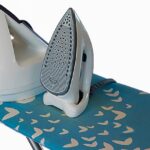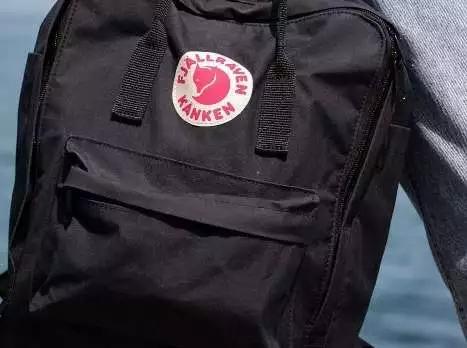Iron-on patches typically have a layer of backing with a thin layer of glue. The heat activates this glue from the iron. Thus, the patch sticks to the material by ironing the iron patches on a fabric.
Even if iron-on patches can be placed on different fabric types, many people still ask whether it is possible to iron-on patches on polyester. This question mainly arises from the fact that polyester is highly flammable and very light.
Thus, if a fabric made from polyester blend is subjected to high temperatures needed to iron patches, there is a chance that your polyester garment could get burnt.

Can You Iron-on Patches To Polyester?
With some care, it is possible for you to iron-on patches on Polyester. Alternatively, you can also use fabric adhesives or sew the patch on polyester if you are concerned that the iron-on patch might damage your Polyester fabric.
Typically, iron-on patches are common on jeans or cotton fabrics. However, when you want to iron a patch on any material, you will need to have a good iron that generates enough heat since the heat is required to activate the patch’s adhesive so that the patch is affixed to the fabric.
How To Iron-on Patches On Polyester?
Now that we found it’s possible to iron-on patches to polyester fabrics, you could be looking to actually go ahead and iron on a patch on your polyester. Here is a process that I have used many times and achieved good results.
Step 1: Make Sure You Have Everything Needed
You will need the following:
Iron-on patches that have sufficient heat-activated adhesive. You can tell this by looking at the backing since the best iron-on patches have a shiny adhesive.
Polyester fabric.
Iron.
Iron board or a craft table.
Thin towel/cotton fabric.
Step 2: Set Up The Iron Board Or The Craft Table
Since you will be using the iron heat to activate the adhesive on the iron-on patches, you will need to make sure that the iron board is well set. If you do not have an iron board, you can use your craft table.
All needed here is a good working space to do the ironing and affix the iron patches. If using a craft table, make sure that a soft cloth, preferably a towel or cotton, is placed on top of the table.
Step 3: Identify The Actual Spots Of Your Polyester Fabric To Patch Iron-on Patches
This step is crucial since if you want good results, you first need to identify the exact position where you want your iron-on patches to be attached before starting the actual process.
If you have a blouse, you might want the patch to be on the pocket or the sleeves, while if you have a trouser, the patch could be on the back pocket or other preferred location.
Step 4: Turn The Iron-on
Different irons take different times to heat up. Therefore, you must give your iron some time to heat up. Since polyester is highly flammable, I recommend that you initially set your iron to its medium heat.
The reason for doing that is to ensure that the high heat will not damage your polyester. Moreover, you also need to make sure that you are not using the steam function on your iron since if you use it, the low heat will not be enough when you place the iron-on patch on the fabric.
Step 5 – Placing The Patch On Your Fabric
Assuming that the iron has heated up to the highest temperature that polyester can accommodate (medium iron temperature that is usually between 110 to 150 degrees), you will lay your polyester fabric on your ironing board or craft table.
Place your iron-on patch on your polyester fabric – precisely where you want the patch to be. Then, cover the iron-on patch with a piece of cotton.
Attentively, place your medium heated iron over the iron-on patch. Immediately press the iron down as much as you can. If your patch is not very big and can be covered entirely by the iron, place the iron on the top of the entire patch.
If your patch is big and cannot be covered all at once, you should start covering one end, proceeding to the other end of the patch while also making sure that the patch is not disturbed as you move the iron.
For about 35 – 45 seconds, gradually move the iron in round motions on top of the patch to ensure that all parts of the patch come into contact with the heat from the iron. You must ensure that the iron does not rest in one position for long.
Step 6: Let The Patch Cool
Now that you have finished placing your iron-on patch on the polyester fabric, you have to give time for the adhesive on the patch to cool down before you can take the polyester fabric from the ironing board.
Cooling time should be anything between one minute to two minutes.
Step 7: Test The Iron-on Patch On Your Polyester Fabric
Once the patch has cooled down, it is time to text the iron-on patch to ensure that it has stuck to the fabric well.
Try to lift the patch from different places gently. You also need to ensure one of your hands is holding the patch in its place as you test it since if it is not well attached, the patch could move.
If you realize that some parts of the patch are not attached to the fabric well, you will need to redo the process again. If the patch is not attached well for the third time, consider increasing the heat on your iron slightly as it shows the heat is not adequate to activate the adhesive on the patch.
Step 8: Process Completed
You have completed placing an iron-on patch on your polyester fabric. Take care of the fabric and the patch, and you will have it for a long time.
Do Iron-on Patches Work On Denim?
Yes, iron-on patches work very well on denim. Indeed, both denim and cotton fabrics are considered to be the perfect fabrics for denim as these fabrics can withstand heat, making them excellent choices for iron-on patches.
However, that does not imply that iron-on patches cannot work on other fabrics such as polyester since they do. However, when placing the patches on other materials such as polyester, one needs to be cautious as the material is highly flammable.
How Long Do Iron-on Patches Last?
In most cases, iron-on patches last on the fabric, anything between 23 – 25 washes. If you want the patches to last longer than that, you should consider sewing since when the patch is sewed instead of ironing it, it will last longer.
How To Take Care of Iron-on Patches
After having an iron-on patch on your garment, you need to take great care of the patch so that it lasts for a long time. Since the patch is affixed to the fabric by an adhesive, you must wash the patches gently.
Specifically, hand washing is the best option for you to clean clothes that have iron-on patches. By handwashing the patches, you make sure that you avoid having the patch have torn threads.
If you feel that you have to wash the patch by machine, it is recommended that you turn the cloth or garment with the patch inside out to minimize the chances of the threads on the patch being torn.
Moreover, make sure that you set your washing machine to gentle mode and in cold water since if you use hot water, the adhesive that sticks the patch on the fabric will lose some of its value. Likewise, the tumble drier should be set on the lowest heat level available for your machine to dry the garment.
If possible, it is recommended that you handwash the garment since when a washing machine is used, there is a high chance that agitation in the washing machine would damage the patch.
Do Iron-on Patches Come Off?
Yes, iron-on patches can come off due to different reasons. For example, if you wash your iron-on patches with a washing machine, the adhesive on the patch is likely to lose its strength resulting in the patch coming off.
To avoid the iron-on patch falling off, always make sure that you do not wash the iron-on patches with hot water or use high temperatures to dry clothes with iron-on patches.
In addition, if the garment with the iron-on patch is ironed, it is essential to avoid the iron-on patch on the garment coming into contact with the heat from the iron since the heat can make the adhesive on the patch loose.
Can You Use A Hair Straightener For Iron-on patches?
Yes, you can use a hair straightener on iron-on patches. The method is actually easy and faster when compared to using an iron.
When using a hair straightener to work on your iron-on patches, you first have to make sure that you warm the hairdryer. After that, take your iron patch and place it on the exact location of your garment where you want it to be.
You then place the hair straightener on the iron-on patch already placed on the garment. Hold the hair straightener in place for about 35 seconds to 60 seconds. Unless your iron-on patch is tiny, you will move the hair straightener around the patch till the point where the patch is well affixed to the fabric.
If you are unsure where you can use the hair straightener and not damage the fabric or the iron-on patch, take a foil and cover the hair straightener heating part. The heat sent to the patch will be reduced, making it for you to seal the patch at your own pace and with no damage to the patch.
Iron-on Patch on Nylon
Since many clothes are made of nylon, you might be wondering whether it’s possible to attach an iron-on patch on nylon. As you are aware, nylon is a synthetic fabric and highly flammable. Therefore, attaching an iron-on patch to your nylon fabric is not advisable.
To activate the adhesive on the back of the iron-on patch, a lot of heat is needed, and when this heat comes into contact with your nylon fabric, you will end up burning your garment. Therefore, it would be best to try using patches that can work with glue alone or carefully sew the patch on your nylon garment.
Final Thoughts
Iron-on patches are used for different reasons. When well attached to denim or any other clothing, they are attractive and can make one stand out from the crowd. If you want to have an iron-on patch on your polyester fabric, you can use the procedure outlined to attach the patch expertly to your fabric.






